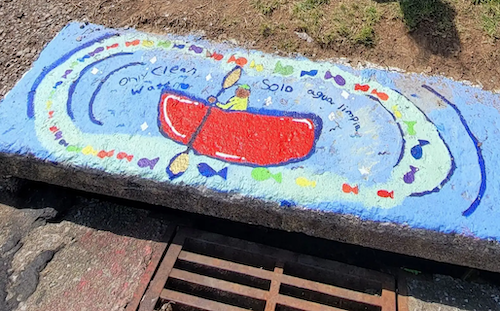June 11, 2025
Cardinal Valley Elementary’s recent motto is “showing kindness to the Earth, our community and ourselves,” said art teacher Michelle Armstrong. The Art of Humankindness, a project funded by CommonSpirit Health's Mission and Ministry Fund, helped fulfill all three of those areas.
The K-5, Title I school is one of seven in Fayette County benefiting from the Art of Humankindness grants, part of Saint Joseph Health’s Creating Safe Neighborhoods Initiative, in the 2024-25 school year.
Using grant funds for art supplies, fourth and fifth graders in the school’s Art Club focused on kindness to the Earth and community by painting four storm drains in nearby Wolf Run Creek at the request of a local conservancy group. Students created designs, while Armstrong cleared the drains of debris and primed them. The club went on a field trip to paint them with illustrations of animals that live in the watershed habitat along with clean water slogans.
“It turned out beautifully,” Armstrong said. “All of the storm drains have that same message of clean water in the storm drain, let’s keep our creek clean. They were super excited to do it and I think they felt very proud of their work, also.”
One facet of the Art of Humankindness grants calls for community involvement, extending the kindness concept beyond the school—"to help them explore out in the community, to get them familiar with other people who may be in vulnerable positions or vulnerable situations and help them to be kind to those people, and build that compassion and empathy,” said Demetria Blair, program manager for Saint Joseph Health’s Creating Safer Neighborhoods Initiative in Fayette County.
Cardinal Valley students schoolwide also did an art exchange using supplies paid for by the grant; for example, each first grader drew a picture of a community helper and gave it to a fourth grader, who then made a model of the subject from recycled materials and gave the model back to the younger student. Art exchanges focused on friendship were made between kindergarten and third grade; and second and fourth grades used an animal theme.
“They were excited to make something for someone else and they were also excited about receiving something,” said Armstrong, a 31-year veteran teacher who is retiring this year. The project resulted in some new friendships and also helped students think of others and “ways people are kind to others,” she added.
Her art classes also incorporated neurographic drawings—an art therapy tool—this year, to show students they can use art as a vehicle if they’re feeling stressed and to show kindness to themselves. “I’ve always been a firm believer that art is therapeutic and healing, and brings people together—and I feel like this (Art of Humankindness) demonstrated all of those key components as well,” Armstrong said.
The Art of Humankindness also was designed to involve other subjects in the curriculum. “Art bleeds over naturally into other content areas,” Armstrong said, “and I think it’s a way to help kids retain things from those other content areas and make that other content maybe more exciting.”
